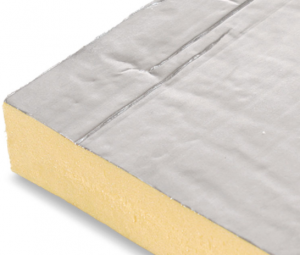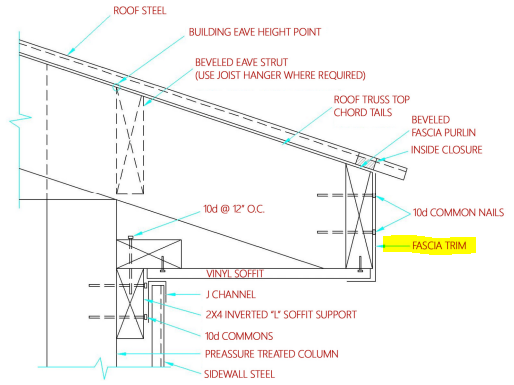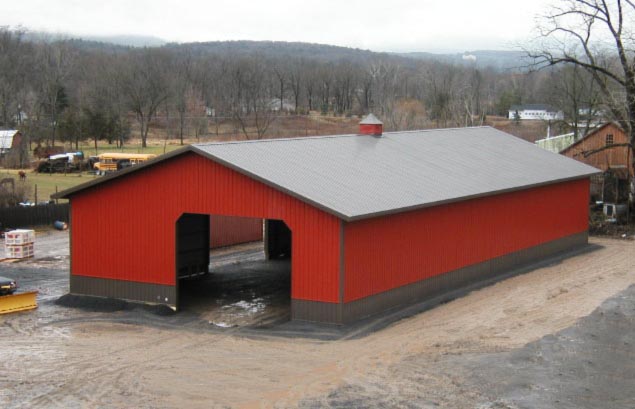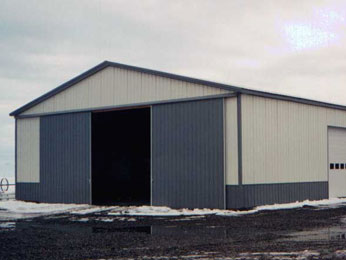High-Density Rigid Fiberglass Board
As I am prone to do, I spend hours on the internet perusing looking for new or better products and applications. Basically – how to make a better post frame building, without hurting client’s in their pockets.
Continuous insulation has become an IECC (International Energy Conservation Code) staple, with 2021’s version showing it as an optional portion of wall insulation in Climate Zones 3 and greater. Usually in board form, in post frame construction continuous insulation is best placed on the inside of wall framing, covering all structural members. Continuous insulation reduces energy loss by providing a thermal break and impeding air leakage.
Most common choice for continuous insulation is a foam board – usually (and my choice) expanded polystyrene (EPS), extruded polystyrene (XPS) or polyisocyanurate (PIR), however there are other ways to achieve this objective. One lesser-known (according to article I was reading at certainteed.com), but effective, alternative is high-density rigid foam board.
Interesting – a design solution I knew little about.
 CertainTeed offers CertaPro® Board – composed of resin-bonded glass fibers in a range of densities. It can be used to add both thermal insulation and sound absorption to interior spaces. CertaPro® board stiffness ranges from rigid to more flexible for curved and/or sharp-edged applications (granted we do not find many curved applications in post frame construction).
CertainTeed offers CertaPro® Board – composed of resin-bonded glass fibers in a range of densities. It can be used to add both thermal insulation and sound absorption to interior spaces. CertaPro® board stiffness ranges from rigid to more flexible for curved and/or sharp-edged applications (granted we do not find many curved applications in post frame construction).
CertaPro® board is available unfaced, or faced with a vapor retardant finish in either clean metallic (FSK) or attractive white (ASJ) surface. CertaPro® boards are easily cut to size and shape and to install. Additionally, unfaced and FSK faced CertaPro® boards are compliant where a fire hazard classification of 25/50 is required, can be used for exposed or non-exposed applications, resist mold and mildew and will not rot or deteriorate.
In applications where walls will dry to interior, unfaced boards should be used. For drying to exterior (higher numbered Climate zones), use products with a vapor retardant finish.
All CertaPro® boards offer a minimum R value of four (4) per inch.
Tag Archives: Expanded Polystyrene
Reader JASON in WINDSOR writes:
“What are ways to avoid a stone base for slab to protrude under grade board using a post in the ground or pier with wet set brackets? We want grass to grow right up to the building’s base rather than stone around the perimeter or stone flower beds. I don’t like the idea of moist soil on treated grade board. Also have questions in regards to fascia trim provided by Hansen’s kit. Tried to ask the sales rep and he couldn’t answer. With packed is the fascia trim two piece application? Meaning one that covers soffit material on bottom of fascia board and one that overlaps bottom piece acting as drip edge. In Kevin Hart’s build and kit review video he claims Hansen only provides one piece and it goes on after roof metal is on leaving wood exposed. I’m thinking he’s missing a piece or step. Lastly the infamous questions of spray foam on roof. Tyvek or straight to metal? Thanks in advance.”
Mike the Pole Barn Guru says:
For those reading along at home, you may want to grab a tub of popcorn and watch Kevin and Whitney Hart’s video review: www.youtube.com/watch?v=sYGF1YY_yZQ
There are several ways to avoid having your slab’s stone base from coming out from beneath your grade board (aka splash plank). If this building is to be heated or cooled, you are in Climate Zone 4. 2021 International Energy Conservation Code (IECC) requires slab perimeter insulation for climate zones 3 and higher. This can be achieved by use of rigid board EPS (expanded polystyrene) R-10 insulation (and keep your stone where it belongs). Inside of your splash plank attach insulation boards so the top is 3-1/2″ above the bottom of the splash plank. You can then use this to screed your slab from. Climate zones greater than 3 require this to be four feet in depth, however you can go two feet deep, then out horizontally following https://www.huduser.gov/publications/pdf/fpsfguide.pdf
Grade boards (splash planks) are pressure preservative treated to UC-4B requirements and should not experience premature decay issues when in contact with moist soil.

On fascia trims, we’ve used a plethora of different variations before settling on our current model. We do use a one piece fascia L trim, sized so it entirely completely covers the fascia board, there is no exposed wood. With properly placed inside closure strips at the extreme downhill edge of fascia, we have never experienced water getting behind fascia L trim. We did try a shorter height L fascia trim, with an eave trim and found the angle of eave trims caused drip edge of eave trim away from fascia trim. When screws were placed thru eave trim to prevent this – eave trims puckered out away from fascia trim between screws.
Closed cell spray foam is best applied directly to roof or wall steel. https://hansenpolebuildings.com/2020/04/spray-foam-insulation-3/
Please reach out to me any time with questions.
This Monday the Pole Barn Guru answers questions about a new a heated floor in a new workshop, adding a large sliding door to a building, and the metal gauge of a beverage can.
DEAR POLE BARN GURU: Hello, New fan of your site 🙂 We are designing a 40×80 pole building workshop for heavy equipment, with radiant in-floor heating. Contractors want to use rigid foam board under the concrete, we are concerned about crushing under the weight of equipment, and then the concrete cracking. What do you suggest?
Thank you, AL and LORI in COLUMBUS

OLYMPUS DIGITAL CAMERA
DEAR AL AND LORI: Welcome, I am hopeful you have gained some information of value. Your 40 x 80 pole building workshop would be very happy as a new Hansen Pole Building.
Your concrete contractor is correct you will want to install XPS (Expanded Polystyrene) foam sheets over your vapor barrier (and below concrete). You can specify a product’s compressive strength, but it appears even standard 25 psi should be adequate.
Although I have not tried it myself, I have read of others who have had two to four inches of closed cell spray foam applied directly over their prepared site. This would both act as a vapor barrier and as under floor insulation.
DEAR POLE BARN GURU: How much does a 20 foot wide x 13 foot high metal single sliding door with track and hardware cost installed in zip 51561 CHARLEY in PACIFIC JUNCTION

CHARLEY: We are not building contractors, so would have no idea. You might try contacting the Pro Desk of your local The Home Depot® to see if they could recommend a contractor who could tackle your project.
DEAR POLE BARN GURU: What gauge metal is the wall of an aluminum beer can or Coke can? How many millimeters thick is it? LETITIA in ONEONTA
DEAR LETITIA: My now adult children have accused me of being a wealth of knowledge when it comes to all things of worthless trivia. It just so happens I have written an article on this very subject: https://www.hansenpolebuildings.com/2012/05/steel-thickness-2/






